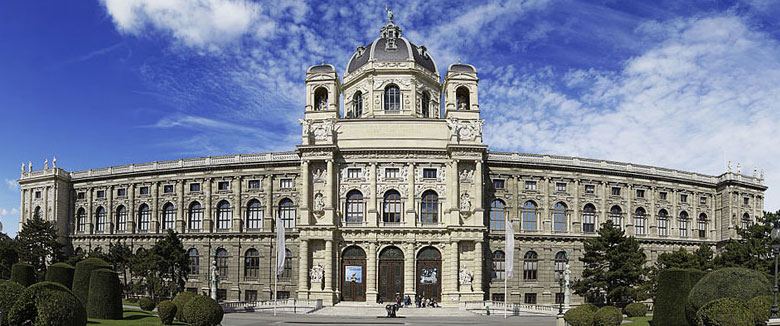- Home
- Project Overview
- Members
- Partners
- Meetings
- Events
- Resources
- Deliverables
- Contact Us
- Home
- Programme
- Topics and Invited Speakers
- Registration and Abstract Submission
- Venue
- Travel Information
- Accommodation
- Proceedings
The organizers gratefully acknowledge the generous support of:
Venue

The Natural History Museum Vienna is one of the largest, oldest, and most noteworthy natural history museums in the world and a centre of competence for scientific questions of fundamental importance. It hosts several reference (scientific) collections, including the world's oldest meteorite collection, of which a large number of specimens is shown in the Meteorite Hall, the world's largest meteorite display.
The museum is home to world-famous and unique objects, such as the 29,500-year-old Venus of Willendorf, the Steller's sea cow that became extinct over 200 years ago, enormous dinosaur skeletons, and many other spectacular objects to be seen in the 39 exhibit halls.
It not only has a long history of curating rare and precious objects, it is also one of the largest non-university research institutions in Austria. In the seven research departments of the museum, more than 60 scientists are performing basic research in various fields of geosciences, biosciences and human sciences, including the study of the composition of the Earth and the origins of the universe as well as the development and proliferation of primitive plants and animals, biodiversity and genetics.
About Vienna
Vienna is the capital and largest city in Austria. It is the 7th largest city by population in the European Union. The city is host to many international organizations, including OPEC and one of the four official seats of the United Nations Organization.
For seven consecutive years (2010–2016), the human-resource-consulting firm Mercer ranked Vienna first in its annual "Quality of Living" survey of hundreds of cities around the world. The center of Vienna was designated a UNESCO World Heritage Site.
Various architectural styles can be discovered. Imposing structures range from magnificent classicist buildings to modern architecture. Friedensreich Hundertwasser himself designed many of the well-known buildings which should be planned in each city trip. The Ringstrasse is well-known for its late-19th- century grand buildings, monuments and parks. The Romanesque Ruprechtskirche, Baroque Karlskirche, Gothic Stephansdom, Highbaroque Jesuitenkriche, Rococo Schönbrunn Palace, Baroque Belvedere Palace are only a few of the impressive buildings in Vienna which a tourist should not miss.
Vienna is known for its classical music. Mozart, Beethoven, Haydn and Schubert recognized the glory of this city to use it as a muse for composing their brilliant masterpieces. The wonderful sounds of these and other prominent composers are still accessible in the operas, concert halls and other facilities, which are famous for its pomp and circumstance.
Traditional coffeehouses are ready to be explored at every turn in the city. Since 2011 the “Viennese Coffee House Culture” belongs to the intangible cultural heritage of UNESCO. Male waiters in tailcoats will serve the wide variety of coffee drinks on silver patters on marble tabletops and the whole historical atmosphere would be topped off with piano music.
A huge variety of different museums can be visited. The Kunsthistorische Museum and Naturhistorische Museum are located close to Museumsquartier. The Museumsquartier houses a number of museums such as the Museum of Modern Art and Leopold Museum which contains the largest collection of paintings by Egon Schiele. As the former imperial mews of Empress Elisabeth of Austria, the Museumsquartier is now used as a public space which features cafés, galleries and squares for music and other performances.
 This project has received funding from the European Union's Horizon 2020 research and innovation programme under grant agreement No 640190.
This project has received funding from the European Union's Horizon 2020 research and innovation programme under grant agreement No 640190.



